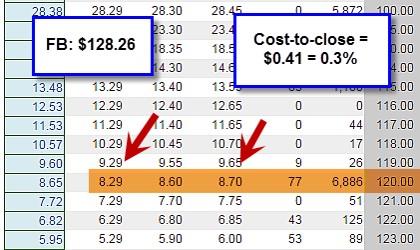Covered call writing and selling cash-secured puts involve buying and selling stocks and options. We work meticulously to do everything possible to throw the odds in our favor to result in successful trades. Achieving the highest level of returns in a low risk manner is one of our mission statements. I have frequently highlighted the three required skills to become an elite option seller:
- Stock selection
- Option selection
- Position management (exit strategies)
All three of these talents involve trade executions and the timing of these trades are another way of elevating our degree of success. In this article, we will explore the best time to execute our trades for each of these required skills.
Initiating our covered call Monthly position (buy stock and sell option)
I initiate my trades during the first week of a Monthly contract usually on Monday or Tuesday after expiration Friday. The reason relates to the time value erosion that Theta has on our option premiums as shown in the chart below:

For near-the-money strikes, time value erosion is logarithmic in nature (starts off slowly and then “falls off a cliff”), not linear. If we wait too long, we will lose out on a significant amount of time value premium.
Now, let’s get even more specific. I will enter my initial trades between 11 AM ET and 3 PM ET. The reason for this is to avoid early morning and late afternoon market volatility caused by computerized institutional trading (mutual funds, hedge funds, banks and insurance companies). By limiting our initial trades to these four hours we will avoid most of that volatility and uncertainty.
Closing our short call mid-contract
20%/10% guidelines
This is the easiest mid-contract exit strategy to achieve because we can automate it. After initiating the short call sale, set a limit order to buy back the option (BTC) at 20% of the original options sale price in the first half on the contract and change to 10% in the latter part of the contract. For example, if we sold the original option for $2.00, immediately set a BTC (buy-to-close) limit order (GTC-good-til-cancelled) at $0.40 and change to $0.20 mid-contract. A closing trade will be executed based on the price threshold.
Mid-contract unwind (MCU) exit strategy
This one requires a bit more effort. We close mid-contract when time value component of the option approaches zero which will occur when share price appreciates significantly. When the original trade is opened we can check the option chain to see which strikes are trading near parity (all intrinsic value and time value near zero). Here is an option chain for Facebook (NASDAQ:FB) from 9/30/2016:

With FB trading at $128.26, we see the $120.00 strike trading near parity ($0.41 of time value). To close mid-contract the cost-to-close is o.3%. This alerts us to follow the option value whenever our strike is $8.00 or more in-the-money. As a general rule, it makes sense to check the time value component of our sold option whenever share value moves up significantly.
Rolling options as expiration approaches- let’s talk Greeks
Since Theta will have a more deleterious impact on the near month strike than it will on the far month strike, it is to our advantage to execute this exit strategy as close to 4 PM ET on expiration Friday as possible. I wouldn’t wait until the very last minute (say 3:45 PM ET) as there may be a glitch in the online broker platform. I usually begin rolling my options about 2:30 PM ET on expiration Friday. If I’m travelling, I may initiate these trades on Thursday. The benefit of waiting until Friday afternoon is small but it does exist.
Discussion
The success of a trade is never guaranteed but we can sure throw the odds dramatically in our favor. One way of improving our results is to be cognizant of the most beneficial times to execute our trades. These times will vary depending on the type of trade being initiated.
Market tone
Global stocks moved up this week after the US Federal Reserve stated that it will raise rates gradually and the populist Freedom Party fared worse than expected in Dutch elections. West Crude oil prices were little changed, holding below $50 per barrel on continued high inventories. Volatility, as measured by the Chicago Board Options Exchange Volatility Index (VIX), stayed about the same, at $11.28. This week’s reports and international news of importance:
- The U.S. Federal Reserve’s rate-setting committee pushed policy rates up another quarter of a percent at its March 15th meeting and indicated that it expects to hike rates twice more this year
- Chair Janet Yellen said that the Fed’s economic forecasts have not changed since the last rate hike in December and that the pace of future rate hikes would be gradual
- Yellen also said the Fed has confidence that the economic recovery is robust and is resistant to shocks. Despite the Fed hiking rates at two of its last three meetings, financial conditions are easier today than they were on the day of the Fed’s December hike: Equity prices are higher, the 10-year U.S. Treasury note yield is lower, the dollar is weaker and corporate bond spreads are narrower
- While the Bank of Japan is not in a position to hike rates anytime soon, the Bank of England might be closer to a hike than markets expected
- The People’s Bank of China raised its reverse repo rate 10 basis points in an effort to keep the USD/CNY exchange rate stable and limit capital outflows. Thursday’s hike was the second this year. However, China’s official monetary policy benchmark deposit rate remains unchanged. While policy rates outside the United States are unlikely to rise dramatically anytime soon, the trend toward additional accommodation appears to be coming to an end
- After several weeks of legislative wrangling, the UK parliament this week passed the European Union (Notification of Withdrawal) Bill and the queen has given Royal Assent, clearing the way for the government to begin negotiations to leave the EU. The two-year process is expected to be triggered by the end of this month
- Support for Geert Wilder’s Freedom Party faded in the final days of the Dutch general election campaign with his party finishing a distant second to the Liberal Party, led by Prime Minister Mark Rutte
- U.S. treasury secretary Steven Mnuchin is set to meet with his G20 counterparts for the first time this weekend in Germany. Trade and currency issues will no doubt be at the top of the agenda. Mnuchin met with German finance minister Wolfgang Schaeuble on Thursday, with Mnuchin vowing to avoid trade wars while seeking to secure reciprocal trading arrangements
THE WEEK AHEAD
MONDAY, MARCH 20
TUESDAY, MARCH 21
- Current account (% of GDP) Q4
WEDNESDAY, MARCH 22
Existing home sales Feb.
THURSDAY, MARCH 23
- Weekly jobless claims 3/18
- New home sales Feb.
FRIDAY, MARCH 24
- Durable goods orders Feb.
- Markit manufacturing PMI March
- Markit services PMI March
For the week, the S&P 500 moved up by 0.24% for a year-to-date return of 6.23%.
Summary
IBD: Market in confirmed uptrend
GMI: 5/6- Buy signal since market close of November 10, 2016
BCI: I am currently fully invested and have an equal number of in-the-money and out-of-the-money strikes. A 25-basis point March interest rate hike was exactly what the market was expecting.
WHAT THE BROAD MARKET INDICATORS (S&P 500 AND VIX) ARE TELLING US
The 6-month charts point to a slightly bullish outlook. In the past six months, the S&P 500 was up 11% while the VIX (11.66) declined by 27%.
